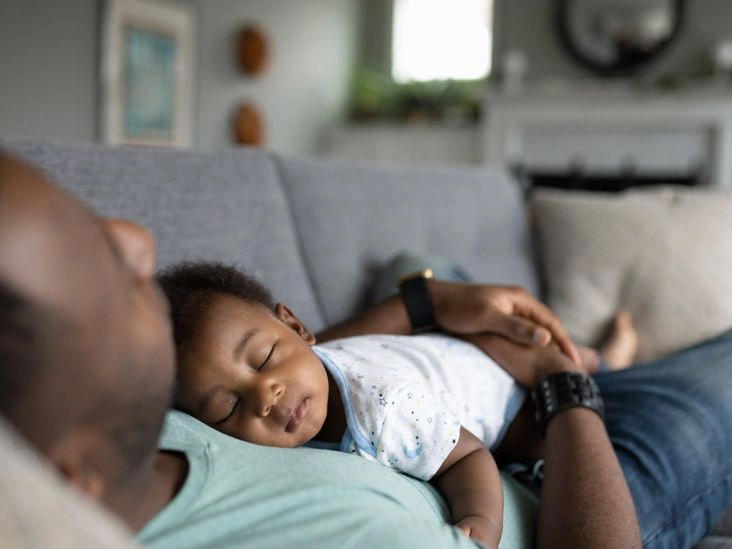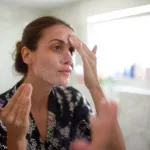For caregivers with a newborn at home, restful nights can feel like a distant fantasy. Even if you’ve moved past the stage of frequent nighttime feedings, your infant may still struggle to fall asleep or stay asleep.
Pediatricians often suggest calming routines — such as a warm bath — to encourage better sleep. When standard approaches don’t help, some parents turn to alternatives like white noise.
Although white noise can assist infants in drifting off, there are possible long-term drawbacks to consider.
Weighing both the advantages and disadvantages is important before making white noise your primary sleep strategy for your baby.

What is white noise for infants?
White noise describes sounds that mask other background noises in an environment. For people living in busy areas, for example, white noise can help cover up traffic or street noise.
Specific ambient sounds are often used to promote sleep regardless of environmental interruptions — for instance, rainforest or gentle ocean waves.
There are even devices made specifically for babies. Some models include instrumental lullabies or a heartbeat track intended to imitate the mother’s heartbeat.
A notable 1990 study found evidence that white noise might be effective: researchers observed 40 newborns and reported that 80 percent fell asleep within five minutes of hearing white noise.
The benefits of white noise for babies
White noise may help infants settle more quickly.
It can also mask household sounds, like those made by older siblings.
Certain infant white noise machines offer a heartbeat option that could soothe newborns by recreating a familiar in-womb sensation.
White noise can help with falling asleep
The clearest advantage of white noise is its potential to help babies fall asleep faster. If your baby often nods off during noisy moments outside of routine naps or bedtime, they might respond well to white noise.
An infant who is used to living amid ambient sounds might find total silence disruptive when it’s time to sleep.
Sound machines can mask family noises
White noise devices can be especially useful in families with children of different ages.
For example, if a baby needs to nap while an older sibling who no longer naps is active, white noise can help conceal sibling activity so the baby can sleep more easily.
The drawbacks of white noise for babies
- Some white noise machines may produce volumes that exceed recommended limits for infants.
- Infants can grow dependent on white noise to fall asleep.
- White noise isn’t effective for every baby.
Possible developmental risks
Despite its advantages, white noise isn’t without potential hazards.
In 2014, the American Academy of Pediatrics (AAP) evaluated 14 infant-oriented white noise machines and discovered that every unit surpassed the recommended noise cap for hospital nurseries, which is 50 decibels.
The researchers concluded that repeated exposure to those sound levels could harm infant hearing and auditory development.
Following the AAP’s findings, pediatricians advise placing any white noise device at least 7 feet (about 200 cm) away from your baby’s crib, and keeping the volume below the device’s maximum level.
Risk of reliance on white noise
An infant who sleeps better with white noise may become reliant on it. This becomes problematic when the sound source isn’t available.
Situations such as travel, staying overnight at a relative’s home, or daycare attendance may be disruptive if the baby expects and does not have access to that background noise.
Not all babies respond positively
White noise doesn’t suit every infant.
Because sleep needs and preferences vary widely among babies, introducing white noise can be a process of trial and error. If you try it, make sure to follow safety recommendations.
Why sleep matters for infants
When adults consider sleep deprivation, they often picture groggy, irritable days fueled by caffeine. In babies and young children, sleep loss may be less obvious but still significant.
Some issues linked to insufficient sleep in infants include:
- increased fussiness
- more frequent irritability
- marked mood swings
- hyperactive behavior
How much sleep should your baby get?
Understanding recommended sleep amounts helps address the effects of sleep loss. Here are guideline averages by age:
- Newborns: Up to about 18 hours a day in total, with waking every few hours for feedings.
- 1 to 2 months: Babies may sleep 4 to 5 hours at a stretch.
- 3 to 6 months: Nighttime sleep might total 8 to 9 hours, plus brief daytime naps.
- 6 to 12 months: Around 14 hours of sleep per day, including 2 to 3 daytime naps.
Remember these are general averages. Individual infants may need more or less sleep than these recommendations.
Next steps
White noise can be a useful short-term strategy for helping your baby sleep, but it’s not a universal solution.
Given the potential unavailability of white noise in some settings and the possible risks, relying on it may create more challenges than benefits for some families.
Keep in mind that young infants, particularly those under 6 months, often wake during the night due to needs such as feeding, diaper changes, or comfort. It’s not always reasonable to expect them to sleep uninterrupted.
If your baby continues to have trouble sleeping independently as they grow, discuss concerns with your pediatrician.


















Leave a Reply
You must be logged in to post a comment.